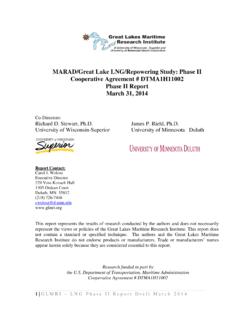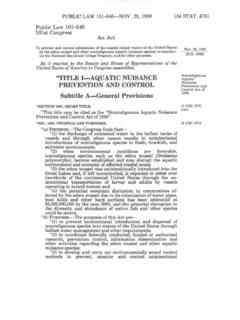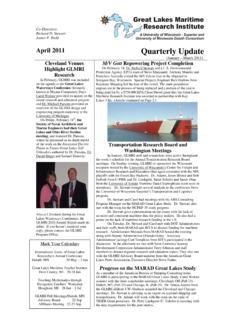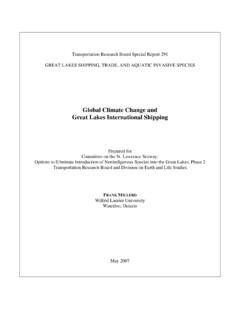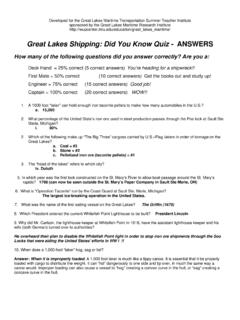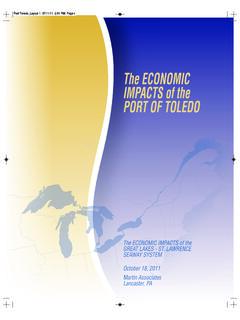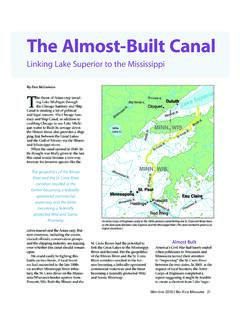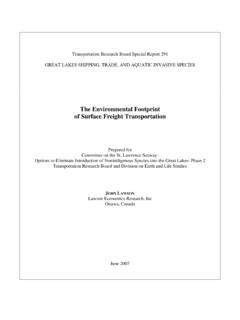Transcription of Revitalizing Coastal Shipping for Domestic Commerce
1 Revitalizing Coastal Shipping for Domestic Commerce John Frittelli Specialist in Transportation Policy May 2, 2017. Congressional Research Service 7-5700. R44831. Revitalizing Coastal Shipping for Domestic Commerce Summary In recent years, Domestic shipborne Commerce has lost much of its market to other modes. Although potential Shipping routes run parallel to congested truck, railroad, and pipeline routes along the Atlantic and Pacific coasts and in the great Lakes region, the volume of cargo carried by Domestic ships has declined by 61% since 1960, while the volume carried by other modes, including river barges, has more than doubled. Use of Domestic ships has retreated to routes where overland modes are not available, such as between Hawaii, Puerto Rico, and Alaska and the mainland, and where oil pipelines do not exist or are at capacity.
2 One reason for the comparatively lower usage of Domestic Coastal and great Lakes Shipping is that despite their inherent efficiencies, ships are often not the lowest-cost option for Domestic shippers. ships cost six to eight times more to build than the equivalent cargo capacity provided by rail and barge equipment. The comparatively high cost is related to the absence of foreign competition in shipbuilding and the lack of economies of scale at shipyards. container ports are widely considered to be much less efficient than ports in Europe and Asia, some of which are fully automated. A 2013 study examining the feasibility of Coastal container services on the East Coast found that port handling costs were the largest cost element ship operators would face.
3 Ship crewing costs are inflated by subsidies provided to crews aboard international trading ships that have government-impelled cargoes reserved for them. Domestic ship lines compete with the international fleet when hiring maritime officers. cargo shippers have responded to the comparatively high cost of Domestic ship transport by turning to land modes, exporting goods instead of selling them domestically, and utilizing oceangoing barges instead of ships for Coastal transport. Oceangoing barges cost less to construct, and can require only a third as many crew as Coastal ships. Since 1960, coastwise and great Lakes tonnage carried by barges has increased 356%, while ship tonnage carried on these waters has decreased by 61%.
4 However, oceangoing barges have significant disadvantages: they are less efficient for longer voyages, and their use does not preserve the shipbuilding and maritime crewing capabilities Congress has sought to protect. Oceangoing barges mainly carry petroleum products, suggesting that commercial shippers do not find them attractive for other types of cargo. Reviving Coastal Shipping would dramatically increase the capacity of the nation's freight network. Moreover, some of the necessary infrastructure is largely in place, as many of the harbors the federal government dredges for deep-draft vessels currently have little or no ship traffic. The question is whether a different mix of federal policies would make Coastal trade an attractive option for shippers and ship owners.
5 To revive Coastal Shipping , the cost issues would need to be addressed. Further information on the causes of the high cost of ships, the justification for the crewing disparity between oceangoing barges and Coastal ships, and whether automation would lower cargo-handling costs at ports would be useful in evaluating policies that might revitalize Coastal Shipping . Congressional Research Service Revitalizing Coastal Shipping for Domestic Commerce Contents Introduction .. 1. Ships as a Method of Transporting Freight .. 1. The Decline of Coastal 2. Higher Construction Cost of Ships .. 6. Federal Ship Financing Assistance .. 7. Cargo Preference Applies to Imported Ship Components.
6 8. Cargo-Handling Costs .. 9. Ship Crew Costs .. 10. Market Response to High Coastal Shipping Costs ..11. Import Barge Substitution .. 12. Panama Canal No Longer Used for Domestic Commerce .. 14. Coastal Shipping Has Shrunk to Captive Markets .. 15. Loss of Competitive Markets .. 15. Ore and Scrap for Steelmaking .. 15. Megasize Loads .. 16. Higher-Value Cargo .. 16. A National Maritime Strategy .. 17. Figures Figure 1. Percentage Change in Tons Carried, 1960 to 2014 .. 3. Figure 2. Domestic Waterborne Tonnage, 1960 to 2014 .. 4. Figure 3. Modal Shares, Domestic Freight 2014 .. 5. Figure 4. Coastwise Tonnage by Vessel Type .. 13. Tables Table 1.
7 Comparative Cost of a Ship .. 7. Table 2. Per-Container Port Costs .. 9. Table 3. Waterborne International Compared to Domestic Shipborne Trade .. 12. Table 4. Manufactured Products Shipped Domestically on the great Lakes .. 17. Contacts Author Contact Information .. 18. Congressional Research Service Revitalizing Coastal Shipping for Domestic Commerce Introduction Congress has shown great concern about the performance of the nation's freight network. In the 2015 surface transportation reauthorization, the Fixing America's Surface Transportation Act (FAST Act; 114-94), Congress stated a national policy of improving the condition and performance of a National Multimodal Freight Network to help the United States compete in the global economy while mitigating the adverse environmental impacts of freight movement.
8 The law authorized funding to improve freight transportation infrastructure, directed the Department of Transportation (DOT) to identify freight choke points and critical Commerce corridors, and required state departments of transportation to establish freight performance targets. The law also called upon DOT to establish performance metrics for seaports. DOT forecasts that Domestic freight tonnage will increase by 40% over the next three decades, and that truck tonnage will increase by 44%.1 Some of the most congested truck routes, such as Interstate 95 in the East and Interstate 5 in the West, run parallel to Coastal Shipping routes, and water shipment through the Saint Lawrence Seaway and the great Lakes has the potential to relieve pressure on major east-west highways, pipelines, and railroads in the Midwest.
9 Coastal and great Lakes Shipping , therefore, may offer opportunities to facilitate Commerce along these corridors. In recent years, however, Domestic shipborne Commerce has generally lost ground to truck and rail freight. This is despite long-standing policy intended to promote use of the merchant marine, particularly deep-draft oceangoing ships, with financial assistance provided to shipbuilders, ship owners, and ship crews. A 2007 law authorizing federal support for projects intended to divert truck and rail freight to parallel waterways has been unsuccessful in reversing this One reason for the declining cargo volumes of Domestic Coastal and great Lakes Shipping is that aspects of federal maritime policy tend to raise the cost of transporting goods by ship relative to other modes.
10 Also, port costs appear to be a particular barrier to diverting truck freight to a Coastal waterway. This report examines recent trends in waterborne freight movement within the United States and offers policy options that might strengthen the competitive position of Coastal and great Lakes Shipping in the face of robust demand for freight transportation. Ships as a Method of Transporting Freight Under a different mix of federal policies, ships could be a least-cost method for moving goods. They do not need to acquire and maintain rights-of-way like railroads and pipelines. They can move much more cargo per trip and per gallon of fuel than trucks and railroads.










